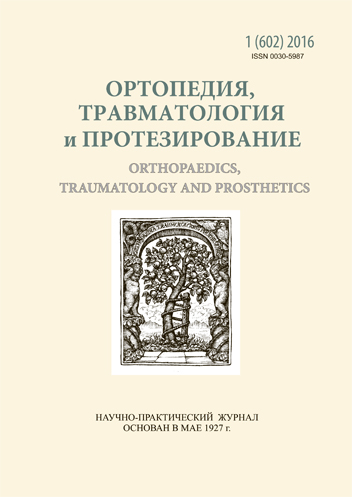Stress-strain state of fibrin-blood clot and periosteum in the area of diaphyseal fracture under different conditions of fracture fragments fixation and its impact on the structural organization of regenerate
DOI:
https://doi.org/10.15674/0030-59872016162-71Keywords:
diaphyseal fractures, osteosynthesis, fibrin-blood clot, the stress-strain stateAbstract
The goal: using mathematical finite-element modeling to calculate the stress-strain state (SSS) of fibrin-blood clot and periosteum around the fracture zone in the conditions of fixation of femur fragments with on-bone plate, intramedullary locking nail and ExFix.
The methods: the model represents two fragments of femur with transverse fracture plane joined with spindly fibrin-blood clot enclosed in periosteum and devices mentioned above. The existing data on the Young's modulus and Poisson's ratio of all components of the model were used. The calculations of SSS of clot and periosteum were performed under axial load of 800 N on femur and transverse load of 200 N on the distal femur. The control points on the horizontal section of clot and periosteum were selected for a quantitative comparison of the voltage in various conditions of fragments fixation. Moreover, the area covered by the maximum stress level was compared.
The results: The following patterns were revealed. At the same axial load of model the lowest level of stress in periosteal-fibrin spindle was observed when fragments were fixed with intramedullary locking nail, a little more — with plate, and the biggest one — with ExFix. The ratio of the stress values was 1: 2: 3–4.At the same transverse load of model the lowest level of stress in periosteal-fibrin spindle was observed when fragments were fixed with plate, a little more – with intramedullary locking nail, and the biggest one — with ExFix. The ratio of the stress values was 1: 6: 10–12.The greatest difference in stress levels was noticed in the conditions of transverse load on the segment.
Conclusion: The presented data on SSS in tissues around the fracture zone explain the origin of sizes, shapes and structures of periosteal bone regenerate in the treatment of diaphyseal fractures with devices with different modes of mobility of bone fragments.References
- Richardson M. Industrial polymeric composite materials. Moskow: Chemistry, 1980. 224 p.
- Berezovskiy VA, Kolotylov NN. Biophysical characters of human tissues. Kiyv: Naukova dumka, 1990. 183 p.
- Bilinskiy PI, Chaplinskiy VP,. Andreichin VA. Comparative theoretic analysis of biomechanical osteosynthesis aspects at transverse tibia fractures with contact and low contact plates (the first issue). Trauma. 2013;14(2):63–71.
- Zubov V. G. Mechanics. Moskow: Science, The main edition of physical-math. lit., 1978. 352 p.
- Knets IV, Pfaford GO, Saulgosis YG. Deformation and destruction of solid biological tissues. Riga: Zinatne, 1980. 465 p.
- Korzh NA, Klimovitskiy VG, Goncharova LD, et al. The concept of union mechanism of diaphyseal fractures from the point of internal bone tensions. Orthopaedics, Traumatology and Prosthetics. 2007;(2):82–93.
- Popsuishapka АК, Litvishko VА, Ashukina NА, Danischuk ZN. Perculiarities of fibrin- blood clot formation, its structure mechanical properties and its importance for bone regeneration after fracture. Orthopaedics, Traumatology and Prosthetics. 2013;(4):5–12. doi: http://dx.doi.org/10.15674/0030-5987201345-12.
- Popsuishapka AK, Borovick IN. Properties of biomechanical construction «femur fragments-apparatus of external fixation» and perculiarities of periosteal regeneration in childhood. Orthopaedics, Traumatology and Prosthetics. 2007(1):44–50.
- Popsuishapka ОК, Litvishko VА, Ashukina NА. Clinical and morphological stages of bone fragments union after fracture. Orthopaedics, Traumatology and Prosthetics. 2015;(1):12–20, doi: http://dx.doi.org/10.15674/0030-59872015112-20.
- Rublenick IM, Shaiko-Shaikovskiy OG, Vasuk VL. Intramedullary metal-polymer osteosynthesis at the fracture treatment and its concequences. Chernivchi, 2003. 175 p.
- Popsuishapka OК, Litvishko VI, Borovick IM. Functional treatment of diaphyseal fractures with od devices for intense and resistant fragments connection. Methodical recommendations. Kiyv, 2014. 46 p.
- Claes LE, Heigele CA. Magnitudes of local stress and strain along bony surfaces predict the course and type of fracture healing. J Biomech. 1999;32(3):255–66.
- Gere JM, Timoshenko SP. Mechanics of material. Boston- London: PWS, 1997. 912 p.
- Gross TS, Edwards JL, Mcleod KJ, Rubin CT. Strain gradients correlate with sites of periosteal bone formation. J Bone Miner. Res. 1997;12(6):982–8.
- McBride SH, Evans SF, Knothe Tate ML. Anisotropic mechanical properties of ovine femoral periosteum and the effects of cryopreservation. J Biomechanics. 2011;44(10):1954–59. doi: 10.1016/j.jbiomech.2011.04.036.
- Janmey PA, Winer JP, Weisel JW. Fibrin gels and their clinical and bioengineering applications. J R Soc Interface. 2009;6(30):1–10. doi: 10.1098/rsif.2008.0327.
- Evans SF. Top down bottom up approaches to elucidating multiscale periosteal mechanobiology: Tissue level and cell scale studies. Department of Biomedical Engineering Case Western Reserve University, 2012. 19 p.
- https:ru.wikipedia.orgwiki mechanical strain.
Downloads
How to Cite
Issue
Section
License
Copyright (c) 2016 Valeriy Litvishko, Olexey Popsuishapka, Oleksandr Yaresko

This work is licensed under a Creative Commons Attribution 4.0 International License.
The authors retain the right of authorship of their manuscript and pass the journal the right of the first publication of this article, which automatically become available from the date of publication under the terms of Creative Commons Attribution License, which allows others to freely distribute the published manuscript with mandatory linking to authors of the original research and the first publication of this one in this journal.
Authors have the right to enter into a separate supplemental agreement on the additional non-exclusive distribution of manuscript in the form in which it was published by the journal (i.e. to put work in electronic storage of an institution or publish as a part of the book) while maintaining the reference to the first publication of the manuscript in this journal.
The editorial policy of the journal allows authors and encourages manuscript accommodation online (i.e. in storage of an institution or on the personal websites) as before submission of the manuscript to the editorial office, and during its editorial processing because it contributes to productive scientific discussion and positively affects the efficiency and dynamics of the published manuscript citation (see The Effect of Open Access).














